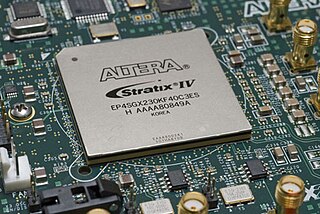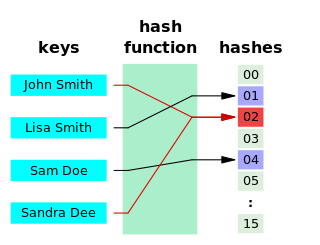
A field-programmable gate array (FPGA) is an integrated circuit designed to be configured by a customer or a designer after manufacturing – hence the term "field-programmable". The FPGA configuration is generally specified using a hardware description language (HDL), similar to that used for an application-specific integrated circuit (ASIC). Circuit diagrams were previously used to specify the configuration, but this is increasingly rare due to the advent of electronic design automation tools.

A hash function is any function that can be used to map data of arbitrary size onto data of a fixed size. The values returned by a hash function are called hash values, hash codes, digests, or simply hashes. Hash functions are often used in combination with a hash table, a common data structure used in computer software for rapid data lookup. Hash functions accelerate table or database lookup by detecting duplicated records in a large file. One such application is finding similar stretches in DNA sequences. They are also useful in cryptography. A cryptographic hash function allows one to easily verify whether some input data map onto a given hash value, but if the input data is unknown it is deliberately difficult to reconstruct it by knowing the stored hash value. This is used for assuring integrity of transmitted data, and is the building block for HMACs, which provide message authentication.
In computing, a linear-feedback shift register (LFSR) is a shift register whose input bit is a linear function of its previous state.
Wavetable synthesis is a sound synthesis technique used to create periodic waveforms. Often used in the production of musical tones or notes, it was developed by Wolfgang Palm of Palm Products GmbH (PPG) in the late 1970s and published in 1979, and has since been used as the primary synthesis method in synthesizers built by PPG and Waldorf Music and as an auxiliary synthesis method by Ensoniq and Access. It is currently used in software-based synthesizers for PCs and tablets, including apps offered by PPG and Waldorf, among others.
In computer science, a lookup table is an array that replaces runtime computation with a simpler array indexing operation. The savings in terms of processing time can be significant, since retrieving a value from memory is often faster than undergoing an "expensive" computation or input/output operation. The tables may be precalculated and stored in static program storage, calculated as part of a program's initialization phase (memoization), or even stored in hardware in application-specific platforms. Lookup tables are also used extensively to validate input values by matching against a list of valid items in an array and, in some programming languages, may include pointer functions to process the matching input. FPGAs also make extensive use of reconfigurable, hardware-implemented, lookup tables to provide programmable hardware functionality.
A random-access memory digital-to-analog converter (RAMDAC) is a combination of three fast digital-to-analog converters (DACs) with a small static random-access memory (SRAM) used in computer graphics display controllers to store the color palette and to generate the analog signals to drive a color monitor. The logical color number from the display memory is fed into the address inputs of the SRAM to select a palette entry to appear on the data output of the SRAM. This entry is composed of three separate values corresponding to the three components of the desired physical color. Each component value is fed to a separate DAC, whose analog output goes to the monitor, and ultimately to one of its three electron guns.

Xilinx, Inc. is an American technology company, primarily a supplier of programmable logic devices. It is known as the semiconductor company that invented the field-programmable gate array (FPGA) and created the first fabless manufacturing model.
SRL or S.R.L. may refer to:
A maximum length sequence (MLS) is a type of pseudorandom binary sequence.

A rainbow table is a precomputed table for reversing cryptographic hash functions, usually for cracking password hashes. Tables are usually used in recovering a password up to a certain length consisting of a limited set of characters. It is a practical example of a space–time tradeoff, using less computer processing time and more storage than a brute-force attack which calculates a hash on every attempt, but more processing time and less storage than a simple lookup table with one entry per hash. Use of a key derivation function that employs a salt makes this attack infeasible.

In the film industry, 3D lookup tables are used to map one color space to another. They are commonly used to calculate preview colors for a monitor or digital projector of how an image will be reproduced on another display device, typically the final digitally projected image or release print of a movie. A 3D LUT is a 3D lattice of output RGB color values that can be indexed by sets of input RGB colour values. Each axis of the lattice represents one of the three input color components and the input color thus defines a point inside the lattice. Since the point may not be on a lattice point, the lattice values must be interpolated; most products use trilinear interpolation.
Linux color management has the same goal as the color management systems (CMS) for other operating systems: to achieve the best possible color reproduction throughout an imaging workflow from its source, through imaging software, and finally onto an output medium. In particular, color management attempts to enable color consistency across media and throughout a color-managed workflow.
A digital clock manager (DCM) is an electronic component available on some field-programmable gate arrays (FPGAs). A digital clock manager is useful for manipulating clock signals inside the FPGA, and to avoid clock skew which would introduce errors in the circuit.
Computing with Memory refers to computing platforms where function response is stored in memory array, either one or two-dimensional, in the form of lookup tables (LUTs) and functions are evaluated by retrieving the values from the LUTs. These computing platforms can follow either a purely spatial computing model, as in field-programmable gate array (FPGA), or a temporal computing model, where a function is evaluated across multiple clock cycles. The latter approach aims at reducing the overhead of programmable interconnect in FPGA by folding interconnect resources inside a computing element. It uses dense two-dimensional memory arrays to store large multiple-input multiple-output LUTs. Computing with Memory differs from Computing in Memory or processor-in-memory (PIM) concepts, widely investigated in the context of integrating a processor and memory on the same chip to reduce memory latency and increase bandwidth. These architectures seek to reduce the distance the data travels between the processor and the memory. The Berkeley IRAM project is one notable contribution in the area of PIM architectures.

Xilinx ISE is a software tool produced by Xilinx for synthesis and analysis of HDL designs, enabling the developer to synthesize ("compile") their designs, perform timing analysis, examine RTL diagrams, simulate a design's reaction to different stimuli, and configure the target device with the programmer.
Virtex is the flagship family of FPGA products developed by Xilinx. Other current product lines include Kintex (mid-range) and Artix (low-cost), each including configurations and models optimized for different applications. In addition, Xilinx offers the Spartan low-cost series, which continues to be updated and is nearing production utilizing the same underlying architecture and process node as the larger 7-series devices.

A quotient filter is a space-efficient probabilistic data structure used to test whether an element is a member of a set. A query will elicit a reply specifying either that the element is definitely not in the set or that the element is probably in the set. The former result is definitive; i.e., the test does not generate false negatives. But with the latter result there is some probability, ε, of the test returning "element is in the set" when in fact the element is not present in the set. There is a tradeoff between ε, the false positive rate, and storage size; increasing the filter's storage size reduces ε. Other AMQ operations include "insert" and "optionally delete". The more elements are added to the set, the larger the probability of false positives.
In computing, a logic block or configurable logic block (CLB) is a fundamental building block of field-programmable gate array (FPGA) technology. Logic blocks can be configured by the engineer to provide reconfigurable logic gates.







